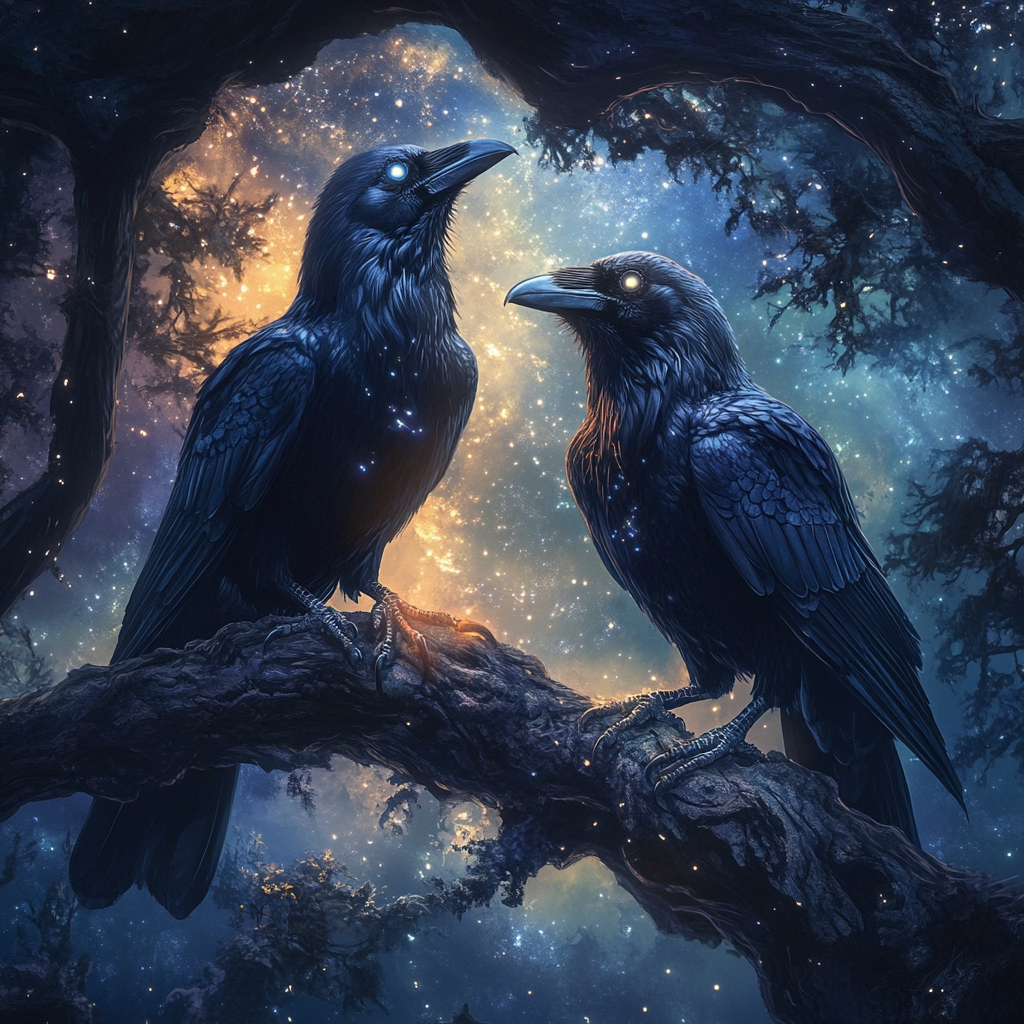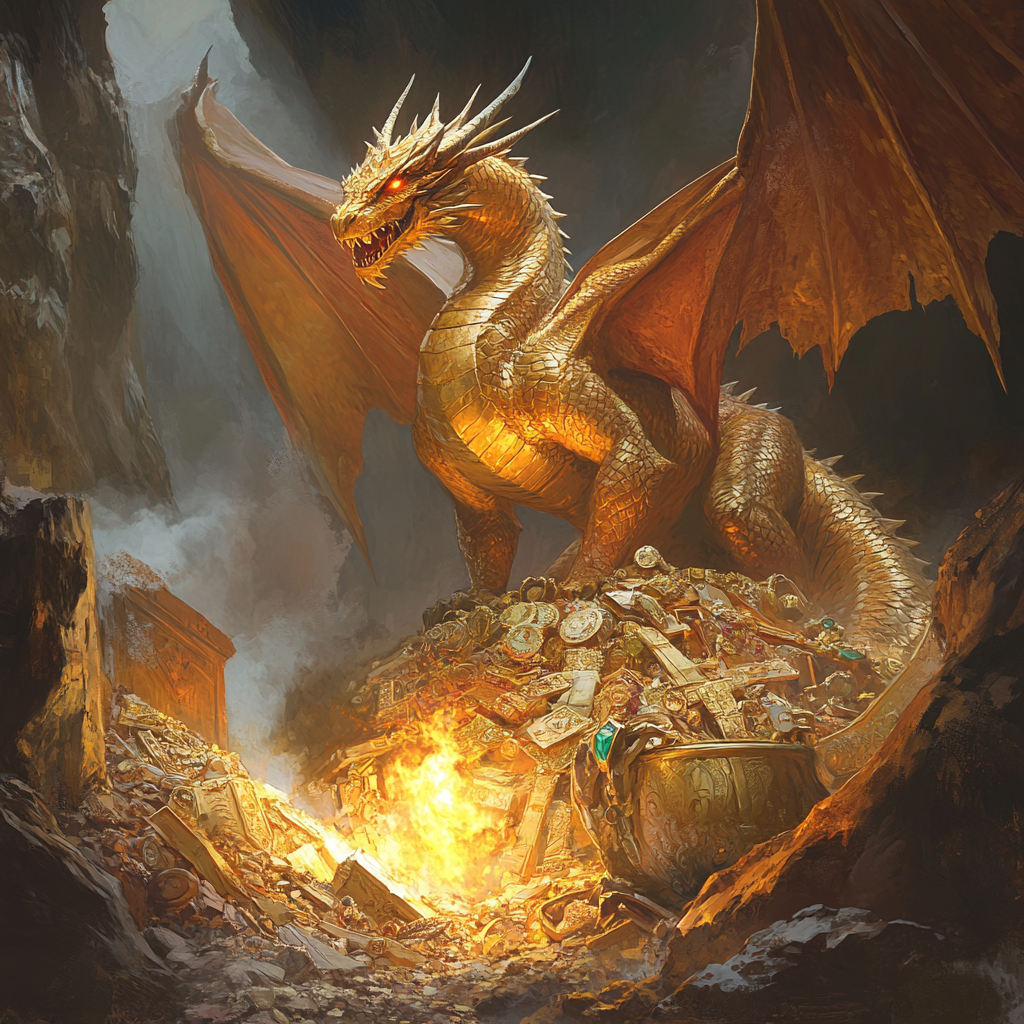Many creatures in norse mythology are powerful and immense, here are some of them that have made our list and captivated many mythology lovers for years.
Grading Criteria: N/A
10: Tanngrisnir and Tanngnjóstr

Tanngrisnir (“Teeth-Barer”) and Tanngnjóstr (“Teeth-Grinder”) are the legendary goats that pull the chariot of Thor. They are known for their incredible strength and a unique regenerative ability—after being sacrificed and consumed during feasts, they can be resurrected, as long as their bones remain intact. Featured in tales from the Prose Edda, they symbolize resilience, sustenance, and the cyclical nature of life. Often depicted as fierce yet loyal companions, Tanngrisnir and Tanngnjóstr are integral to Thor’s adventures, carrying him across the skies as he battles giants and protects the realms.
9: Hugin and Mugin

Hugin and Munin are Odin’s faithful ravens, known as the “thought” and “memory” of the All-Father. These mystical birds soar across the Nine Realms each day, gathering news, secrets, and wisdom to report back to Odin. Hugin represents thought and the active pursuit of knowledge, while Munin symbolises memory, the keeper of the past and the essence of wisdom. Depicted as sleek, black-feathered birds with piercing eyes that see beyond the physical, they are more than messengers—they are Odin’s trusted extensions, embodying his intellectual and spiritual reach. Perched on his shoulders, they whisper what they’ve learned, making them vital to Odin’s role as the god of wisdom, war, and poetry.
8: Sköll and Hati

Sköll and Hati are the fearsome wolves that eternally chase the sun and moon across the sky in a relentless pursuit foretold to culminate in Ragnarok, the end of the world. Their names reflect their nature: Sköll, meaning “Treachery,” pursues the sun (Sól), while Hati, meaning “He Who Hates,” chases the moon (Máni). These celestial predators are children of the giant wolf Fenrir, inheriting his savage strength and apocalyptic destiny. Their chase creates the cycle of day and night, embodying the inexorable passage of time and the natural order’s precarious balance. When Ragnarok arrives, it is said that Sköll will finally devour the sun, and Hati will consume the moon, plunging the world into darkness and chaos. They are powerful symbols of inevitable change, the cyclical nature of existence, and the destructive forces that accompany new beginnings.
7: Fafnir

Fafnir is one of the most infamous dragons in Norse mythology, a symbol of greed and its devastating consequences. Once a powerful dwarf, Fafnir was the son of the sorcerer-king Hreidmar. Greed consumed him after the family acquired a cursed treasure, including the magical ring Andvaranaut. Fafnir murdered his father to claim the hoard for himself, retreating to a desolate wilderness to guard his riches. Over time, Fafnir’s insatiable avarice transformed him into a monstrous dragon, his body grotesquely altered by the curse and his obsession. He became a fearsome guardian, spewing venom to keep intruders away from his treasure. Fafnir’s downfall came when the hero Sigurd (or Siegfried) was guided by the god Odin to slay the beast. Using a sword forged by his mentor Regin (Fafnir’s brother), Sigurd ambushed the dragon, killing him by striking a fatal blow to his underbelly.
6: Sleipnir

Sleipnir is the magnificent eight-legged horse (Pretend this one in the picture has 8 Legs) commonly known as the steed of Odin. As the fastest and most powerful of all horses, Sleipnir can gallop across land, sea, and air, and even journey to the underworld with ease. His eight legs symbolise supernatural speed, strength, and otherworldly abilities, making him unmatched among mythical creatures. Born from a union between the shape-shifting trickster god Loki (in the form of a mare) and the stallion Svaðilfari, Sleipnir is an extraordinary being. Despite his unusual parentage, he is loyal and majestic, described as a sleek, gray steed whose grace and power inspire awe.
5: Nidhogrr

Níðhöggr (often anglicized as Nidhogg) is a fearsome dragon-like serpent that resides at the roots of the world tree Yggdrasil, constantly gnawing at it threatening to weaken and eventually destroy the cosmic structure that binds all realms together. As a creature of chaos and destruction, Níðhöggr is often seen as the embodiment of corruption and decay. His ceaseless gnawing is not merely physical—it represents the inevitable entropy and rot that afflict even the mightiest of structures. He resides in Naströnd, a desolate region in Hel, where he is said to feast upon the corpses of the wicked and oathbreakers, further solidifying his role as a punisher of sins and a harbinger of doom. Níðhöggr’s enmity is not limited to Yggdrasil. He engages in a bitter rivalry with the eagle that resides at the top of the World Tree, with the squirrel Ratatoskr acting as a messenger, carrying insults between the two.
4: Valkyries

The Valkyries are enigmatic and powerful warrior maidens who serve Odin. Their name, derived from Old Norse valkyrja, means “chooser of the slain.” These celestial beings descend onto battlefields, selecting which warriors will die and which will live, carrying the chosen fallen to Valhalla, Odin’s hall, where they prepare to fight alongside the gods during Ragnarok. The Valkyries are often depicted as beautiful yet fierce figures, clad in shimmering armor and wielding weapons, riding swift, winged horses that gallop through the skies. While their primary role is to serve Odin, they are also symbols of fate, as they execute the will of the Norns and decide the destinies of mortals. Beyond their martial duties, the Valkyries serve mead to the einherjar, the honored dead warriors in Valhalla, creating a bridge between the mortal and divine worlds. Some myths portray them as compassionate figures who fall in love with mortal heroes, such as Brynhildr, a Valkyrie who becomes entangled in the tragic saga of Sigurd.
3: Draugr

The Draugr are eerie and malevolent undead creatures, feared for their supernatural strength, cunning, and thirst for vengeance. These beings are the restless corpses of those who, due to greed, hatred, or unresolved grudges, refuse to stay buried and instead rise to haunt the living. Draugr are often depicted as grotesque and decayed, with dark, bloated bodies exuding an overpowering stench of death. Their eyes burn with an unholy light, and they possess immense physical power, far greater than that of any living human. They can shape-shift, control the weather, and even swim through solid rock, making them formidable foes. These undead dwell in burial mounds, guarding their treasures from intruders. Anyone who dares to disturb their resting place risks facing their wrath. Draugr are known to strangle or crush their victims, spreading disease and madness wherever they go. They can also curse the living, making them a symbol of the fear of death and its lingering presence.
2: Fenrir

Fenrir is one of the most fearsome and iconic figures in Norse mythology, a monstrous wolf prophesied to play a pivotal role in Ragnarok, the end of the world. Born to the trickster god Loki and the giantess Angrboða, His immense size, strength, and ferocity struck fear even into the gods of Asgard. From a young age, Fenrir’s power was evident, and the gods, wary of his destined role in their doom, attempted to bind him. After breaking several chains forged by the gods, Fenrir was finally restrained by Gleipnir, a magical ribbon crafted by dwarves from impossible materials such as the sound of a cat’s footsteps and the roots of a mountain. As a precaution, the gods tricked him into being bound, with the god Týr losing his hand as a result of Fenrir’s rage. Bound on the island of Lyngvi, Fenrir remains chained until Ragnarok, when he will break free to wreak havoc upon the world. It is foretold that he will devour Odin during the final battle, only to be slain by Odin’s son Víðarr, who will avenge his father.
1: Jormangandr

Jörmungandr, also known as the Midgard Serpent, is a colossal and fearsome sea serpent and another one of Loki’s children. This is probably one of the most notable creatures in all of Norse Mythology. Cast into the ocean by the gods at birth to prevent his destructive potential, Jörmungandr grew to such immense proportions that he could span the entirety of the world’s oceans. His presence in the waters of Midgard signifies both chaos and balance, as his slumber holds back his apocalyptic power. Jörmungandr is fated to play a key role in Ragnarok, the end of the world. He will rise from the ocean, his thrashing causing massive tidal waves and poisoning the skies with his venom. He is prophesied to battle his eternal rival, the thunder god Thor, in a final, cataclysmic confrontation. Though Thor will slay the serpent, he will only manage to take nine steps before succumbing to Jörmungandr’s venom.
Honourable Mention: Garmr

Garmr is a terrifying wolf that stands as the guardian of Hel, the realm of the dead, Garmr is chained near the entrance to the underworld, where he watches over the souls of the departed. His blood-soaked fur and ferocious demeanor symbolize death and the inevitable destruction that accompanies Ragnarok. When the end of the world begins, he will break free from his bonds, unleashing chaos upon the cosmos. In the final battle, he is prophesied to engage in a climactic fight with the god Týr, the god of war and justice. The two are destined to kill each other in a confrontation that exemplifies the Norse belief in the inescapability of fate, even for gods and monsters. Some traditions equate Garmr with Fenrir, another of Norse mythology’s great wolves, though others view them as distinct beings with unique roles in the mythos. Regardless, Garmr is a symbol of the wild, untamed forces that lie beyond the control of gods and men.
Other Contenders
Jötunn: The giants or frost giants, primordial beings who are often in opposition to the gods.
Ratatoskr: A mischievous squirrel that runs up and down Yggdrasil, carrying insults between Níðhöggr and the eagle at the tree’s crown.
Kraken: A giant sea monster mentioned in later Norse sagas, possibly connected to earlier myths of immense sea creatures.

